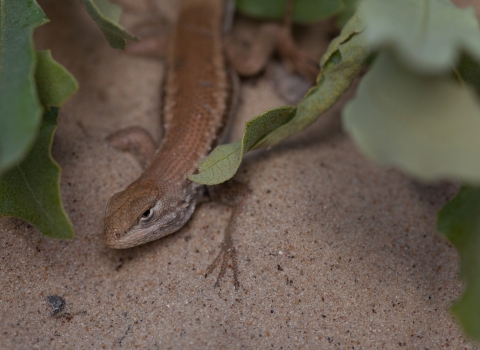In 2021, the U.S. Fish and Wildlife Service added nearly 7,000 acres of public land to the National Wildlife Refuge System in Texas. This brings the total number of Service-managed lands in the state to nearly 700,000 acres at 19 National Wildlife Refuges and three National Fish Hatcheries.
Spanning a variety of ecosystems, from the coastal prairie in the Rio Grande Valley to the hardwood forests in East Texas, these acquisitions aim to connect, protect and restore wildlife habitat and increase recreational access for Texans.
“These public lands offer access to a host of popular activities like hiking, hunting and fishing, while also providing vital habitat for thousands of wildlife species,” said Amy Lueders, the Service’s Southwest Regional Director. “Conservation stewardship and increasing equitable access to public lands are essential components of the America the Beautiful initiative. We encourage Texans to come visit their National Wildlife Refuges to connect with the outdoors and experience some of the state’s most iconic ecosystems and the fish and wildlife that rely on them.”
At Laguna Atascosa National Wildlife Refuge the Service acquired more than 4,933 acres on 10 separate tracts of land. The largest tract, a 3,361-acre addition in Cameron County, was one of the few remaining large parcels in the vicinity of the refuge and is key to creating a wildlife corridor wildlife corridor
To maintain healthy species populations and ecosystems, fish and wildlife need the freedom to move and migrate. As habitats and migration routes are affected by climate change and fragmented by roads, fences, energy development and other man-made barriers, wildlife struggle to reach necessary areas to feed, breed and find shelter. A wildlife corridor is a piece of undeveloped land connecting two habitats so wildlife can move safely between them.
Learn more about wildlife corridor . This property will provide exceptional opportunities for hunters including for upland and migratory birds, waterfowl, and big game species like white-tailed deer. An additional 1,512 acres, known locally as Holly Beach, provide habitat to native and federally endangered species and will expand public use activities on the refuge including hiking, biking, and wildlife observation and photography. The remaining tracts purchased in 2021 are a 53-acre former aquaculture facility that will be shallowly flooded to enhance surrounding vegetation to benefit wildlife, and several tracts of barrier island habitat on South Padre Island that will benefit native vegetation and wildlife.
At Balcones Canyonlands National Wildlife Refuge the Service acquired more than 307 acres of prime golden-cheeked warbler and black-capped vireo habitat in Travis County, growing the refuge to more than 25,000 total acres. In addition to providing great wildlife habitat, the two tracts acquired increase opportunities for public use on the refuge, including hunting, bird watching, photography, wildlife observation, hiking and environmental education.
At Lower Rio Grande Valley National Wildlife Refuge the Service acquired more than 1,500 acres on three tracts of land. On the 1,477 acre La Sal Vieja tract, a salt-dome lake with cultural and historical significance is surrounded by native upland habitat. This noteworthy addition to the refuge will allow the Service to increase its efforts to conserve vegetational paths for wildlife movement between areas of native habitat, while providing the public additional refuge access to participate in wildlife-dependent recreational activities. Another tract consisting of 72 acres of dense native brush will provide cover and breeding habitat for resident wildlife species like white-tailed deer, javelina, coyote, bobcat, doves, and potentially, the endangered ocelot. The third tract, consisting of 10 acres along the Rio Grande, contains riparian riparian
Definition of riparian habitat or riparian areas.
Learn more about riparian floodplain vegetation that will benefit opossums, eastern cottontails, coyotes, raccoons, striped skunks, bobcats, green jays, golden-fronted woodpeckers, doves, flycatchers, hawks, kestrels, and caracaras.
At Anahuac National Wildlife Refuge the Service acquired more than 270 acres of remnant upland prairie habitat to provide necessary wintering, migrating, and nesting habitat for resident and migratory bird species on the Texas Chenier Plain. The property is located within the 100-year floodplain and benefits a variety of native and migratory wildlife species. Eastern black rail will likely occupy the tract, as well as upland migratory birds, doves, eastern meadowlarks, and mottled and black-bellied whistling ducks.
At Neches River National Wildlife Refuge the Service acquired more than 96 acres of bottomland hardwoods adjacent to the Neches River. This acquisition will increase recreational access for canoeing, kayaking, hunting, fishing, hiking, photography, and environmental education.
These acquisitions were made possible with the help of a number of non-profit conservation partners and private donors, including The Conservation Fund, Friends of the Wildlife Corridor and the Delta Lake Irrigation District. Additionally, the Service used Land and Water Conservation Funds, Migratory Bird Conservation Funds, Recreational Access Funds, Deepwater Horizon Natural Resource Damage Assessment Funds, and National Fish and Wildlife Foundation's Gulf Environmental Benefit Funds in combination with $15,752,101 of federal acquisition dollars.
National wildlife refuges provide vital habitat for thousands of species and access to world-class recreation, from fishing, hunting, and paddling to nature watching, photography and environmental education. National wildlife refuges also contribute $3.2 billion per year into local economies and support more than 41,000 jobs, according to the Service’s report Banking on Nature.
The America the Beautiful initiative is a decade-long campaign to conserve, connect and restore 30 percent of our lands and waters by 2030. The effort aims to support locally led and voluntary conservation and restoration efforts across public, private, and Tribal lands and waters in order to create jobs and strengthen the economy’s foundation; tackle the climate and nature crises; and address inequitable access to the outdoors.



